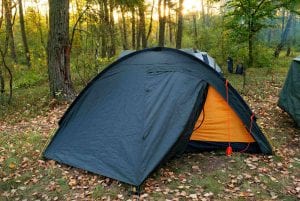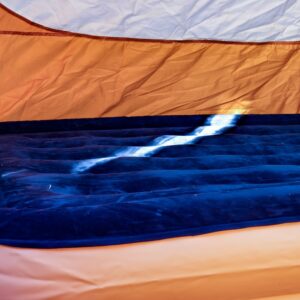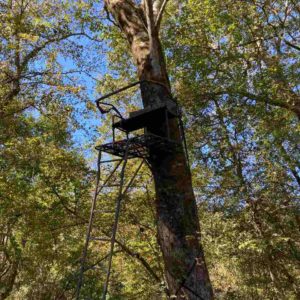If you’re here, my guess is that you’ve already got a good few outdoor trips under your belt and you’re looking for the next challenge. A winter expedition is a very natural graduation but gear requirements can be quite different. Which means it’s worth taking a bit of time to research the best 4 season tents on the market to make sure you get the right tent at the right price.
I get asked for winter tent recommendations quite a lot but the thing is people have different priorities. Are you most worried about the cold? Are we talking about pitching in a campsite? Or will you be hiking a trail for 10 days? Are you an ultralight junkie?
As you can guess, there’s no one-size-fits-all “best winter tent” because everybody’s needs are different. But here’s my opinion for a range of situations.
Best Winter Backpacking Tents
Eureka Alpenlite 2XT Review – Best Value 4 Season Tent

Specs
This tent is a real cracker. You can throw pretty much any sort of weather at her, including heavy snow, and she’ll hold up just fine. There’s tons of ventilation options so you’ll have no fear about condensation. It has a good array of pockets to stow your bits and pieces. And it’s not going to break the bank.
The Verdict
Like a lot of 4 season tents it’s not the most compact. And it’s quite small on the inside (so if you’re not a couple you’ll want to be close friends to sleep two people). The most annoying thing is a slightly weird rear vestibule that you can only get to from the outside…
In Summary…
If you want an all-weather tent that’s super durable and light enough to thru-hike with, you’re going to love this option! If you need more room, check out the MSR Access below…
MSR Access 2 Review – Best Lightweight 4 Season Tent

Specs
The Access comes in 1-person (3.5lbs), 2-person (4.4lbs) and 3-person (5.3lbs) versions and has been designed especially with back-country skiers (and therefore snow) in mind. Because of the design, there’s a really good crossover with other winter climates and it stands up well to wind and rain too.
The Verdict
Some owners have reported issues with a bit of condensation. My take on this is that it’s more about managing expectations. MSR have a great reputation which translates into a bit of a premium when it comes to price. So when things don’t go according to plan, a sense of disappointment sets in. I personally have not experienced any condensation, but it seems that it’s potentially one of the few downsides of owning an otherwise excellent family of four-season tents.
In Summary
If you want a winter tent you can rely on, then you won’t be disappointed by this range.
If you have the budget then you might want to go for the Hilleberg over the Access 1.
But if you’re looking for a well-constructed, lightweight, durable, 2-person or 3-person winter tent you’ll struggle to find a better balance of features than the Access 2 and Access 3.
Alps Mountaineering Tasmanian 2 Review – Best Budget 4 Season Tent

The Verdict
This is a very durable four-season tent for the money. It’s great in snow, rain and wind. It’s also very roomy compared to most 2-person tents. Super-easy to put up and it’s got a fantastic little gear loft. There’s a lot to love about this tent and when you consider the price tag, it’s great value for money.
Unfortunately it is bulky; you’re going to need a fairly large pack to stow it in, even if you use compression sacks. The worst part for me is it’s a bit of a pain to pack up. I like to get moving quickly in the mornings so extra minutes packing using cold fingers can be quite frustrating.
In Summary…
If you like the look of the Eureka Alpenlite 2XT but it’s a bit out of your budget this 4-season backpacking tent is a great alternative. Your compromises will be some extra bulk and fiddly packing up when you break camp. Neither of these issues are insurmountable and it makes for a great first winter tent.
Best 4 Season Family Tents
The North Face Bastion 4 – Best 4 Person 4 Season Tent
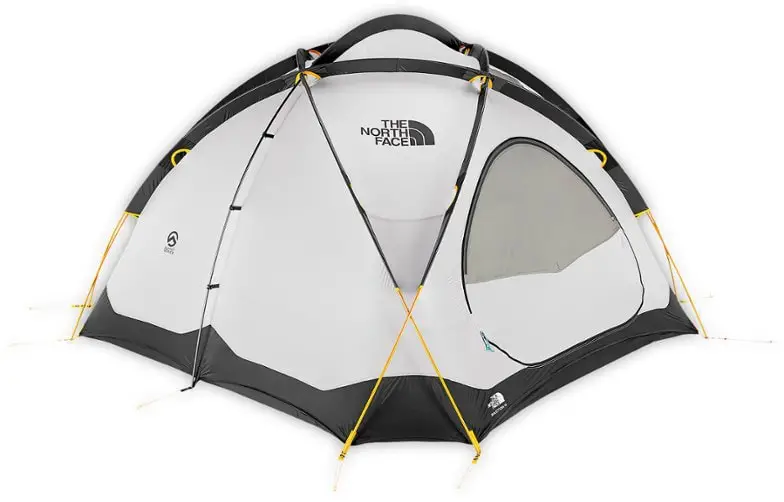
Specs
This tent has floor dimensions of 96 x 96 inches and a total floor space of 61.5 square feet. It has a maximum interior height of 54.5 inches and packs down to just 24 x 9 inches. The packed weight of this model is 13 pounds 4 ounces, but the trail weight is only 12 pounds 4 ounces, and the fast-pitch weight is just 8 pounds and 9 ounces.
It uses a high-low system to provide ventilation and has two doors and two vestibules. The vestibule area at the front is 14.8 square feet and 7.2 square feet at the back.
To strengthen the structure, it has a nylon bucket floor and a polyurethane port window tested to withstand temperatures of minus 60 degrees Fahrenheit.
It’s a 4 season four-person tent with 10 interior pockets and internal hanger loops for all its inhabitants. It also includes four snow stakes for quick installation in snowy conditions.
The Verdict
This tent is the creme-de-la-creme of tents and is exactly what you need to pick up if you’re throwing all budgets out the window to invest in a heavy-duty piece of camping gear.
Nearly every aspect of this model screams premium—from the ultra-light-weight 40D nylon material in the exteriors to the fully integrated high-low venting system to maximize airflow and minimize moisture accumulation along the walls.
It comfortably houses four individuals with an ample floor space of 61 square feet, and each of your fellow campers will have plenty of internal hanger loops to hang your gear from. While you rest easy on the inside, you can be assured that the coated nylon construction and the fully sealed seams will keep any external battles from breaching your tent.
In Summary
We have excluded premium tents from the vast majority of our list, as this is not what most campers are looking for, but the last two spots belong to this segment. This is because you need a premium tent when you’re heading to dangerous territories such as Mount Everest, and this is the type of tent you’d want to carry along on such journeys.
Black Diamond Bombshelter 4P
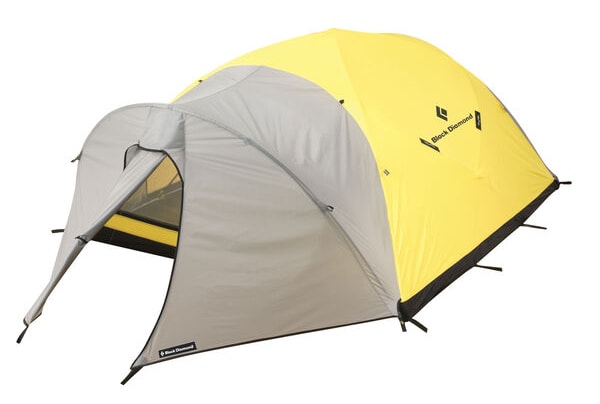
Specs
The Black Diamond Bombshelter has floor dimensions of 90 x 80 x 80 x 44 inches and a total floor area of 50 square feet. The tent packs down to measurements of 8 x 20 inches and has a minimum trail weight of 8 pounds 13 ounces.
This is a 4 season tent that can accommodate four individuals and has two doors and two vestibules. The vestibule area is 20 square feet.
It’s made from ToddTex fabric and has been confirmed as expedition worthy.
It doesn’t include a gear loft but has plenty of storage space thanks to four interior mesh pockets.
The Verdict
If tents around the world have one arch-nemesis, it has got to be heavy winds. How many times have you seen a perfectly stable tent being blown away by a single gust of heavy wind? It’s all too common when you’re not carrying a specialist tent for windy regions.
These are the specific conditions under which this model by Black Diamond really shines. It has been seriously tested to check its stability against heavy winds, and this model has been known to hold up beautifully time and time again.
It manages to achieve this feat with the help of four interior poles that intersect seven times to maximize strength and stability.
Providing two doors and two vestibules ensures that all four occupants can easily enter and exit without disturbing the other members or the grounding of this tent. With a total floor space of 50 square feet, all four users can enjoy their own space within this incredible shelter.
In Summary
One of the worst things that can happen to you while you’re camping is to have your tent blow over your head in the middle of the night; this will never be an issue thanks to this wonderful offering by Black Mountain.
While most tents rely on four to six poles for maximum stability, this model uses its four poles extremely well by intersecting each pole multiple times for maximum performance. This ingenuity allows us to award it the spot of best 4 season tent for windy conditions.
Big Agnes Mad House 6 Review – Best 6 Person 4 Season Tent
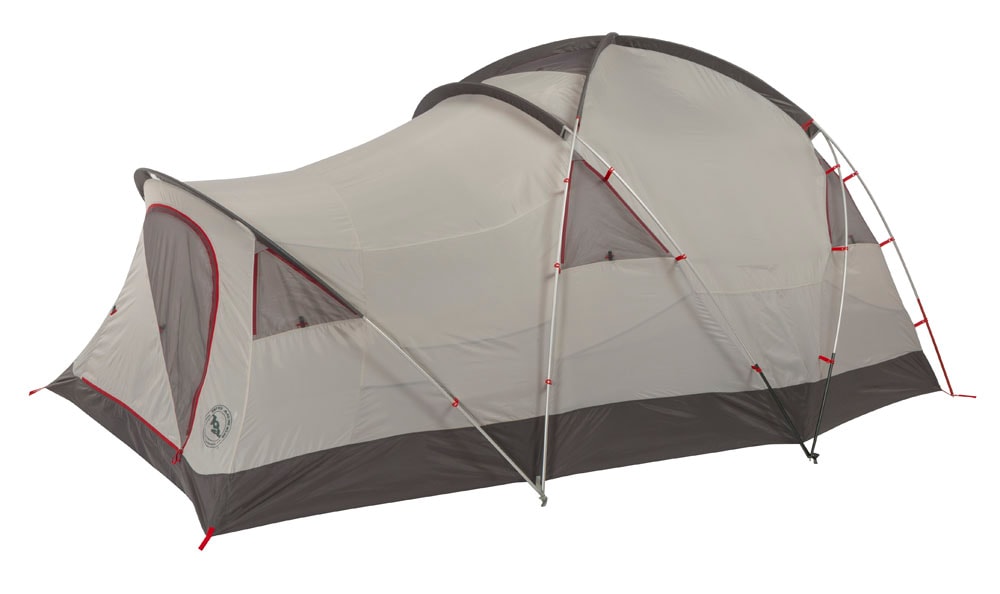
Specs
Big Agnes Mad House is a 6 person 4 season tent that has a minimum trail weight of 19lbs 6oz and a packed weight of 21lbs 8oz. It has a packed size of 26″ x 10″ x 15″ and overall floor area of 94sq feet.
The peak height of this model is 68″ . It has two doors, several vents, and two vestibules with a zip-up mesh door for ventilation. The vestibules measure 26 and 6 square feet and one of them can be converted into an awning.
It comes with 16 interior pockets and 20 light-weight aluminum hook stakes. Gear loft loops are included in this model that can fit a large trapezoid gear loft.
It can be separated into two rooms with the help of a fabric wall (which you can easily turn into one big room) and at the front you can create an awning to extend the space even further.
The Verdict
But it’s not the space that’ll make you fall in love with this beast, it’s the fact it’s virtually bomb-proof. Unlike a lot of family tents, this one has a full rain fly which is guaranteed to keep you dry. The design is so sturdy it won’t budge in all but the strongest of winds. It really is a superb base station tent, suitable for all weathers and extremely durable.
Set up is fairly straight forward. You can definitely do it solo (though 2 people would make it quicker). When it comes to the take down Big Agnes have provided a really well-thought out carry case. Every part of the tent has its place marked out so you pack it away easily and spot any missing parts.
Look, you’re not going to get a large, sturdy, durable, 4-season tent on the cheap. And the Big Agnes Mad House ain’t cheap. That in itself isn’t so bad, because if you intend to use it a lot for the next decade or two, it will pay back your investment.
But at the price I would have expected them to throw in a footprint (which they don’t). And I was disappointed to discover that the stakes felt cheap. For tents at the lower end of the market, I expect to have to invest in a few extra bits and pieces to make things easy and comfortable. And I think BA have let themselves down a bit by not dotting every i and crossing every t. But these are just niggles at the end of the day.
In Summary…
A family will find this a wonderful investment. It’s also going to work for winter hunting. And you know what, even though it 20lbs, I think that you could split it out across a small party to do some comfortable winter backpacking.
Basically, if you want a tent that will stand up to punishing weather season after season AND give you a bunch of space AND be really comfortable… this is going to work for you.
Moose Country Gear BaseCamp 6

Specs
There’s a couple of vestibules for stashing gear (large one out front and a smaller one round back). It’s light, so you you’ve got a bit more flexibility when it comes to use (you’re not just restricted to car camping). It’s a really solid build with a full rain fly which will keep the rain, wind, cold and snow at bay. Setup is easy and it packs down into a slim 2ft bag weighing a pretty reasonable 10lbs.
It’s a fine piece of kit at a great price point!
The Verdict
There are vestibules but there’s no porch. Now, I kinda view a porch as a bit of a nice-to-have so the absence of one isn’t a big deal. But the problem here is that the vestibules mean you end up having to skip around your gear to get in and out of the tent. It’s not a big deal, but it is a bit of a compromise.
The only other thing is you’re not going to fit a large group or a large family in here. It feels more like a tent for sleeping in than a tent for living in.
In Summary…
If you’re in a smaller group and are planning to use a tent primarily for sleeping then this is a really good, solid option. I can’t see anyone regretting buying it.
North Face Assault 2 Review – Best Winter Tent

Specs
The 2-person version weighs in at just under 5lbs. We’re not talking ultra-light here but they are both good lightweight winter companions. They are really spacious (you can trust their size ratings, unlike many!). The seated headspace is phenomenal, it’s got great gear pockets and two vestibules.
Above all, this is a tent you can trust on the side of a mountain!
The Verdict
The only quibble I really have with the Battle Mountain is that it’s a bit on the bulky side when packed. If you love you’re lightweight gear you’ll probably like a small pack so you’ll want to keep that in mind.
In Summary…
If you’re planning to spend a lot of time on the side of a snowy mountain, you really won’t regret having the Battle Mountain with you. For those who are a little less dedicated to winter camping, you might prefer something with slightly lower specs.
How to Choose a 4 Season Tent
So many things can be overwhelming when you’re looking to purchase an all-season tent. There are a variety of options, such as shape, color, and then having to consider if you want a double-wall or single-wall tent.
Choosing one shouldn’t cause any frustration. I’ve put this guide together for you, and I hope that you’ll find it helpful.
How Is a 4 Season Tent Different to Other Tents?
The first notable difference compared to a 3 season tent is that they’re almost always made from brightly colored material, which helps you find the shelter if there’s been heavy snowfall. You’ll also notice that they come in different shapes, such as:
- Teepee.
- Dome.
- Tunnel.
- Cabin.
- Bell.
They are often more angular, with heavier and sturdier poles that help the tent withstand strong winds and heavy snowfall. It’s also bulkier than other tents due to the inner and outer structure, as well as the material which is extremely waterproofed and weatherproofed.
More importantly, 4 season tents come with either a double-layer or triple-layer of material. This provides far greater protection and insulation against sub-zero temperatures. The protection that these additional layers offer may be the difference between hypothermia or even life and death.
The tent walls will all be solid fabric as opposed to mesh, with more robust and sturdier poles to reinforce the strength of the tent. You’ll also find that the tent comes with oversized loops and clips, which makes them easier to work with when you’re wearing gloves in cold weather.
When you’ve set your tent up, you’ll see the poles create an A-frame shape. This will prevent the tent from sagging, lifting, or flexing in the wind, as well as allow for snow to fall away, so it doesn’t gather on top and cause your tent to fall in.
Why Choose a 4 Season Tent Over Others?
There’s no limit on usage or where you can go with a 4 season tent as it offers versatility and variation. If you’re planning a camping trip that’s likely to be treeline, mountaineering, or even basecamp, then investing in a 4 season tent would be a wise choice.
If you’re looking to escape into an Alpine environment then a lightweight, single-walled tent would be perfect. You may look at a more bulky winter tent if you’re planning to go base camping. Whatever your camping needs, it should offer a good amount of variety to choose from and covers all situations.
We can’t guarantee perfect weather conditions; however, the 4 season tent is ready for anything and will stand up to hail, heavy rain, fierce wind gusts, and snow. If you do have a hot day, then it’s easy to unzip the fly, which allows for the summer breeze to cool you down.
All-season tents have thicker frames, durable fly, and vestibules that reach the ground, as well as full fabric sleeves, which help on cold days and when snow builds up around the tent. The 4 season tent is created from an extremely strong material, making it far more durable than other types.
Types of 4 Season Tents
There are two types: double-wall and single-wall tent, both of which have advantages and disadvantages, as well as both having different uses. These will help you narrow down which type best suits your camping needs and should give you some insight when it comes to how to choose a 4 season tent.
Let’s have a look at the differences between the double-wall and single-wall tent:
Double-Wall
The double-wall camping tent is made up of the outer rainfly and the inner tent canopy.
Advantages:
- The double-wall will withstand strong winds, torrential rain, and heavy snowfall.
- It will be a lot warmer than the single-wall tent.
- There’s virtually no draft as there are no wind tunnels.
- More privacy as there’s little open mesh.
- Double-wall tents are almost free-standing, which means that you don’t have to spend time staking the tent.
- Moisture and condensation are caught by the rainfly, leaving the inside of the tent dry.
Disadvantages:
- It will take slightly longer to set up.
- It’s bulkier than the single-wall tent.
Single-Wall
The single-wall tent is exactly that—it has a single layer of material that’s used to protect you from the elements.
Advantages:
- Quicker and easier to set up.
- Lightweight and more compact than the double-wall tent.
- Made from long-lasting, durable, and waterproof material.
Disadvantages:
- Doesn’t offer as much warmth as the double-wall tent.
- Single-wall tents don’t transfer condensation on the interior walls.
- It has less space, fewer doors, and smaller vestibules than the double-wall tent.
How to Choose a 4 Season Tent
There are a number of factors to consider when purchasing your tent, aside from the locations where you’ll be camping. I have broken it down piece by piece to know exactly what to look for when choosing.
Weight and Packed Size
Advancements in technology have made four season tents lighter than ever while still being durable. They almost all weigh between 5 and 10 pounds. However, some can weigh up to 17 pounds.
An essential part of how to choose a four season tent is to consider the type of camping you’re planning on doing and the number of people that will be using the tent. That being said, there are usually three weights advertised when you’re shopping for one, and they are:
Trail Weight: This will be the lightest full setup, and it includes the poles, rainfly, and tent.
Packaged Weight: This is everything that comes in the box and includes the following:
- Tent.
- Poles.
- Rainfly.
- Stakes.
- Guy lines.
- Stuff sack.
- Packaging.
Fastpack: This is only the weight of the footprint, poles, and rainfly.
You won’t always take every tent component with you on a camping trip. As a rule of thumb, your tent will never be heavier than the packaged weight, and it should be closer to the trail weight when it’s in use.
Size and Layout
Size and layout are just as crucial as pack size and weight. If you choose to go with pack size and weight, then you will have to sacrifice some headroom in the tent.
Not all tents are created equal when it comes to livability and interior space. The average person needs approximately 20 square feet of space for the tent to be comfortable. It may seem like that’s a lot of space, but it would also depend on the height and build of an individual. If you’re over 6 feet tall, you’ll likely require more space than someone who’s only 5 feet.
To have a comfortable night’s sleep, when lying on your back, it would be best to have roughly 25 square feet of space per person in the tent. You would also have to take into consideration space for the storage of gear and personal items. An 80 square foot tent, for example, should sleep two adults quite comfortably.
Floor Area
If you want to be comfortable, then you should be able to stretch out in your tent without any part of you touching the walls of the tent. If you’re over 6 feet tall, you should look at a tent length of at least 8 feet.
Another factor to consider is whether a tent has vertical walls or if the walls of the tent slope. Sloping walls can reduce the floor space by as much as 7 inches where the floor and the wall meet.
To make sure that you have good floor space, you should be able to fit two, 25-inch wide sleeping pads comfortably in the tent. This means that the floor space would have to be approximately 5 feet wide. It would also give you enough space inside the tent for your gear and personal belongings.
Peak Height
The peak height is the distance between the highest point of the tent and the floor. This number will determine whether or not you’re able to stand, crouch, or sit in the tent. If you don’t want to feel like the walls are caving in on you, then get a taller tent.
This will also make the tent feel as if it’s more spacious. This can make a big difference if you’re going to be spending a lot of time in it.
Entrances and Vestibules
Tent vestibules come in very handy. They create and provide extra space to either store your wet, muddy gear, or change out of wet clothing before entering your tent. They can also come in very useful if you need to cook dinner and have to find a nook that’s out of the wind, snowfall, or rain.
Just be careful that you don’t set your tent on fire and avoid carbon monoxide poisoning. There are two types of vestibules to choose from, mostly to do with positioning:
- Front vestibules.
- Side vestibules.
The majority of vestibules will depend on the structure of your tent to hold them up, and they don’t have a floor.
Front Vestibules
Front vestibules are often built into the 4 season tent body and are also reasonably large. This is a benefit as you can store all of your gear and have it be protected from the elements, without sacrificing floor space inside the tent.
If you have a two-person tent with two doors, each door will have its own vestibule. Even if they are storing gear, it will still be easy to get in and out of the vestibules.
Side Vestibules
Side vestibules can be used with a secondary exit door to the tent, which will allow people to come and go more easily, especially if you’re sharing the tent with someone else. The side vestibule is generally more spacious and would be great for storing all the gear and keeping the front entrance to the tent clear for people to enter and exit.
If you’re not sharing the tent, then the side vestibule would be a great awning to watch the sunset or have a vantage point to drink coffee and watch the storm roll in. It’s like a private balcony!
Vestibules add value to the camping experience, especially when camping in extreme weather. But if you’re going to be staying in the same place for a few days, or you’re using the tent base camping or mountain climbing, then vestibules are beneficial.
Doors
Could there be anything worse than being woken up in the middle of the night by the person you’re sharing the tent with crawling over you to get to their sleeping bag? This is why it’s always a good idea to get a tent with more than one door, although this would mean that it would be slightly heavier to carry.
Most treeline and base camping tents have two doors, and this also means that you would probably have another vestibule—one on each door. While it may slightly add to the weight of the tent, it also means that you’ll have considerable storage space.
Material
The 4 season tent can be made from different durable and long-lasting materials.
Silnylon
Silnylon is a nylon fabric that has been intertwined with silicone, which is tear-resistant, waterproof, and lightweight. Nylon is known for its ability to absorb water, but in this case, the silicone that’s woven into the fabric makes it extra waterproof. You’ll also get a far better stretch with silnylon, which will make staking down a better experience.
To increase the lifespan of the product, you’d want to avoid excessive daylight exposure, and by keeping the fabric clean, you’ll get plenty of usage out of it.
Silpoly
Silpoly is a combination of silicone and polyester that has been woven together into a fabric. Silpoly is waterproof, windproof, and has an increased UV resistance, which makes it extremely durable.
The other benefits of silpoly are that it’s lightweight, resistant to stretching, and is also heat resistant. Silpoly will also remain taut despite the amount of moisture or temperature when it’s outside in the elements.
Polyurethane
Polyurethane is applied to nylon and polyester fabrics. This helps to make the material waterproof as well as allowing the fabric to have more breathability than when silicone is applied to the surface.
Hydrostatic Head Testing Method
This is the method used to test the waterproof strength of the fabric used in tents and tarps. Waterproof ratings are measured in millimeters. If your tent has a rating of 1500mm or higher, it is considered to be waterproof.
Durability
When you look at how to choose a 4 season tent, it would be wise to look at the type of camping you would be doing and the elements that your 4 season tent will be exposed to. You don’t want your tent to wear out quickly after two camping trips at high altitudes where the tent was exposed to extreme sunlight.
You want to know that your 4 season tent can withstand galeforce winds and be buried under 10 feet of snow. This is why most 4 season tents are made out of a nylon taffeta, which is coated with either silicone or polyurethane.
Your tent can comfortably withstand high winds, heavy snow, and driving rain because the materials are designed to resist extreme weather and temperatures.
Tent Pole Quality
When it comes to 4 season tent poles, they will be stronger than 3 season poles, which can mean that they are slightly heavier. However, they need to be able to withstand gusts of wind. The last thing you want in the middle of a snow-storm is a pole that snaps and ruptures the tent fabric.
In extremely cold environments, the tent fabric will shrink, which can make plastic and metal brittle. This is why most companies use aluminum as the standard material. You can find fiberglass or even high-end carbon fiber tent poles, but they’re less common.
Aluminum tent poles are manufactured from either 6000 or 7000 series aluminum. Depending on this, they’re given an aluminum grading so you can see which one they are made from. The 6000 series is used in aircraft, yacht, and bicycle manufacturing and is extremely strong and won’t corrode.
The aluminum series most frequently used is the 7001, which has the highest yield strength—the point at which the pole will be permanently bent. Tent poles that are made from this will be sturdier, stronger, and will withstand gale-force winds.
So when you’re at 14,000 feet and buried in 10 feet of snow, you can rest assured knowing that your tent poles will keep you safe from harm.
Waterproofing
Weather is unpredictable. You may have gone to sleep in a dry, warm tent, but after three hours of heavy rain, you don’t want to wake up in a wet sleeping bag. Even if you don’t plan on camping in sub-zero temperatures, having a waterproof tent will give you peace of mind.
When you purchase your tent, you want to know that it can stand up to hours of heavy rain and keep you dry. One of the important factors here is what it’s made from. Tents that are made from silnylon or silpolyester are almost perfect, as these materials are specifically made to withstand the outdoor elements.
When it comes to how to choose a 4 season tent, I would recommend getting a tent that comes with a rainfly, as this will just further improve the tent’s waterproofing.
Stakes and Snow Anchors
If you’re planning on camping in the snow, then you would need to look at some different techniques and gear, especially if you’re in an environment with unpredictable weather. You don’t want to have your tent blown away, which is why you’d need to use snow stakes.
Snow stakes, as their name suggests, have been designed to anchor your tent in snow. Some will require you to loop them into the tent guylines and then secure them. You will also need to dig small ditches to either lay the stake in or push it into the ground vertically. Once you’ve filled the hole, make sure that you compact the snow, and then don’t forget to adjust your guylines so that they’re taut.
Even if you’ve secured your stakes, it would be wise to create an anchor as well—better to be safe and keep your tent, than possibly lose it. You can use any object to bury in the snow when you’re creating a deadman anchor, but the most common is a snow fluke.
For it to be effective and extremely reliable, the snow fluke should be angled at 45 degrees from the direction of the pull, and the line must be as straight as possible. The fluke should act as a dynamic anchor and actually burrow deeper when you step on it.
Ventilation and Condensation
Even 4 season tents are prone to some condensation, and proper ventilation will help to alleviate this. Some tents may be more breathable than others, and if we look at the design of the double-wall, they tend to breathe better without you having to freeze or be uncomfortable by leaving vents open.
If you’re camping in sub-zero temperatures it may not be possible to leave every vent open, so to help prevent condensation you can try the following:
- Let your sleeping bag soak up the sun and dry every day. There will be no condensation if your sleeping bag is dry, and it will retain more body warmth.
- Leave wet clothing to dry in the vestibule or put them in a stuff sack and then put them into your sleeping bag so that the items won’t freeze.
- Don’t tuck your head into your sleeping bag. Instead, keep your face clear of the bag as you can create almost a liter’s worth of water during the night just from exhaling into the insulation of your sleeping bag.
- You could be trekking snow into your tent on the bottom of your shoes. This will melt, which will lead to humidity and condensation in the tent. Leave your shoes in the vestibule.
While we may not be able to get rid of condensation completely, these tips should help you to ventilate your tent and reduce any extra moisture.
Ease of Setup
When you’re out in sub-zero conditions, the last thing you want to do is fight with your tent while you’re trying to set it up. Setting up a single-wall tent is going to be easier and quicker than setting up a double-wall tent.
When you’re setting up a double-wall tent, you have to make sure that you have staked it properly, and it will require more staking to secure it. You will have to check on the tension of the rainfly, and that may need adjusting. With rainfly fabrics, especially nylons, they stretch when damp or wet, so be mindful about re-tensioning the rainfly.
This factor shouldn’t make as much difference in how to choose a 4 season tent—it’s more important that you choose something that will keep you warm and dry.
4 Season vs. 3 Season Tents
When it comes down to how to choose a 4 season tent or 3 season tent, it depends on your camping goals and the type of camping you’re going to be doing. The main difference between the 3 season and the 4 season tent is the ability to withstand wind resistance and heavy snowfall.
Best for Versatility and Features
Both the 3 season and 4 season have their advantages and disadvantages, and we’ll take a deeper look at them:
3 Season Tent Advantages
- Used in spring, summer, and fall.
- The tent is highly breathable as it’s made from a large amount of mesh, keeping you cool during hot summer nights.
- Has lighter and thinner poles than the 4 season tent, making the overall weight lighter.
- The tent is easy to set up; most of the 3 season tents have clip-on assemblies.
- Aluminum frames, which makes it strong and long-lasting.
- Great for backpacking.
3 Season Tent Disadvantages:
- Can’t be used in extremely cold weather or heavy snow.
4 Season Tent Advantages:
- 4 season tents are designed to be warmer and more durable.
- Can be used all year round.
- Will keep you warm and protected during severe rainstorms.
- Frames are made from sturdy and durable aluminum.
- Versatility, as you can strip the 4 season tent down to their minimum structure, which will make it a great tent on a summer night. When it gets cold put the tent back together, and this will keep you extremely warm.
4 Season Tent Disadvantages:
- The 4 season tent can be heavier than the 3 season tent, as it’s designed to withstand heavy snowfall and severe wind.
Both tents offer versatility. However, if you’re going to be mountaineering or base camping, then the 4 season tent would be the more reliable and durable tent as it would be able to handle anything that comes its way.
The 3 season tent is great if you are looking for a tent that allows you to go camping where you won’t be exposed to harsh weather conditions for extended periods.
Best for Extended Expeditions
The 4 season tent would be best for extended expeditions. The rugged design and strong materials make it better suited to spending extended time in a harsh environment. Given the amount of mesh on the 3 season tent, it wouldn’t be wise to try and spend long periods of time in snow and frigid temperatures.
The 4 season tent may also be subjected to severe winds, and the additional poles and crossings make the tent stronger, meaning that it also weighs more. This is a benefit when you are having to stake or anchor your tent due to the extreme weather. You won’t mind it being a bit heavier on the climb when it’s keeping you safe from storms and rough weather.
With a stronger flysheet and inner fabric tent, you’ll have much better insulation as opposed to the fabric mesh of the 3 season tent.
Considerations for Bivy Tents and Alpine Climbing
Alpine climbing is not for the faint of heart or for those who are new to climbing, as it requires you to climb an uneven mountain. The goal of Alpine climbing is to reach the summit, and with this in mind, one of the factors to consider is compact and light packing of a tent.
It can be difficult to haul an entire tent with you up a mountainside, and bivy sacks are a great alternative to a tent. They are lightweight, compact, and provide comfortable shelter.
The bivouac sack, commonly known as the bivy tent, can only be described as a single-person, waterproof, full-body shell that looks like a sleeping bag with a breathing hole. There are a few things you should consider when using a bivy sack for Alpine climbing.
Portability
Bivys are compact, and at a weight of 10 ounces, they’re incredibly lightweight. They’re easy enough to stuff down to a tiny ball and keep in a bike packing bag. This makes it easier for you to cover more distances quickly without tiring you out. You’ll find that a bivy tent makes it easier to navigate technical terrain.
Space
When you use a bivy tent, you don’t have to worry about looking for even ground to set up. As long as you can stretch out comfortably, you can sleep in places such as snow caves, rock ledges, and other spaces where it would be impossible to set up a tent.
All you need to make sure of is that the surface you’re on is stable and can support the width and length of you and your bivy. This opens up a new possibility of sites where you can camp and be closer to nature.
Warmth of the Bivy Tent
The bivy is like a cocoon. It traps and insulates your body’s warmth. You want to make sure that the material is breathable and that it has vents to help prevent internal condensation and to keep both you and the bivy sack dry.
I would not recommend using a bivy in areas where there’s a possibility of snow without additional accessories such as a sleeping mat and sleeping bag. However, in the summer seasons when it’s warmer, the bivy would add warmth and insulate you while you sleep under the stars.
If you’re an Alpine explorer, this should definitely factor into how to choose a 4 season tent—although the bivy is technically not a 4 season tent.
Going Ultralight? Consider an Ultralight Shelter
When you go backpacking, you want the shelter that you’re going to use to be as light as possible and to take up as little space as possible. An ultralight shelter would be a great choice.
Although we can’t predict weather patterns, ultralight shelters should be used in spring, summer, or fall, as you still need protection from the elements. While ultralight shelters may be minimalist, they still offer robust protection.
When considering how to choose a 4 season tent, it’s worth looking at whether or not you really need the snow protection. If backpacking is your thing, something like an ultralight shelter would be just fine.
Ultralight Tarp
Tarps are extremely light and easy to set up wherever you may decide to settle for the night. Regardless of what the site may look like, it’s easy to set up a tarp between two trees. If you’re using a flat tarp, you can pitch it at a number of different angles to allow for a shape that offers the most weather protection.
If you’re looking for a bit more protection, you can always get a tarp with a beak. The beak is tapered at one end to hang over and provide additional protection. You could also use an oversized tarp if you’re looking to have more surface area protected or if you want to keep your gear protected when you’re sleeping.
Ultralight Hammock
Hammocks are becoming popular as they offer an easy and lightweight solution that keeps you off the ground when camping. Hammocks also offer more freedom when it comes to choosing your location and where you want to set up camp. All you have to do is tie it between two trees, or hang it between rocks and lean back into it.
You may take some time adjusting to sleeping in the hammock comfortably. It can be used in spring, fall, and summer. The hammock insulates the heat around your body, which helps keep you warm during cool summer nights.
However, if you get cold, you could simply add a bivy or sleeping bag, which will keep you warm. It’s important to note that in colder weather, your body heat would escape from the bottom of the hammock.
Ultralight Pyramid Tent
The pyramid tent is a shaped backpacking shelter which is incredibly light and easy to set up. However, you do need to be mindful of the size of the pyramid tent that you get. If you get a pyramid tent that’s larger than the diameter and height of the shelter, it would mean steeper walls.
If you love the pyramid tent, then you’ll be happy to know that it comes in various sizes and caters to multiple people. Up to four people can fit in one tent, or it can be sized for just one person. The pyramid tent is exceptionally weather-resistant, with a single peak and solid walls that make it wind resistant.
You can use the pyramid tent to go camping on all-terrain, and you can purchase accessories such as a bug liner to keep out mosquitoes. If you’re expecting cooler weather, you can always take a bivy or sleeping bag with you to keep you warm. If you don’t like being too close to nature, then take a groundsheet with you.
Footprint
The footprint uses a separate groundsheet, and most tents don’t come with footprints anymore. Whether or not you use a footprint is a personal choice, although if you’re looking to protect your tent, then adding a footprint will prevent damage to the tent as well as extend its life. This will also mean adding some weight to your pack as well.
Using a footprint can help prevent punctures to the tent, especially if you’re camping on rocky terrain. The footprint is often made out of tough material that will match the size and shape of your tent floor as well as it coming with holes for the tent poles to keep it in place.
The footprint also adds another layer to the bottom of the tent, which can help reduce the amount of heat loss. While it’s not absolutely necessary to have one, depending on the material of your tent and it’s thickness, it may be worth getting the footprint.
Conclusion
When you go camping, you want to make sure that you have the right tent for your needs. First, you’ll need to choose between a 3 season or 4 season tent. Once you’ve decided a 4 season tent is right for you, you need to know how to choose a 4 season tent.
4 season tents have a lower profile. This means that they won’t be affected by the harsh winds or snowfall. They were designed to withstand intense weather and sub-zero conditions, protecting you from the harsh elements.
If you’re going to be a mountain climber, climbing to elevations of 5,500 meters or more, as well as if you go camping in areas where the winters tend to be harsh, then a 4 season tent will definitely be a good choice for you.
You know how to choose a 4 season tent to suit your needs now. Go forth and enjoy camping in crazy weather!

